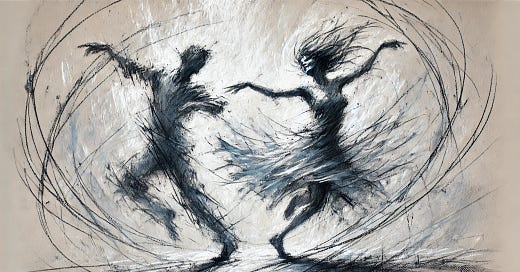The Dancing Waiter
There is a playful rhythm (a kind of dance) that emerges when a sensitive waiter begins to interact with a customer
A Waiter is a Dancer
The more I hone my skills as a waiter, the more I realise that the best waiter is the leading partner in a playful dance - yes, I said it, a truly good waiter is a dancer, and his customers are his partners. The skills and knowledge of a waiter ultimately boil down to anticipating what each customer being served wants - even before the customer is cognisant of it him/herself. In this way just like a skilful dancer, the waiter must discern the kind of dance his partner is in the mood for and on such a basis take the first step and lead his partner where s/he wants to go. Yes, just like the leading dancer, the waiter is in control, but the way he is exercising his control should depend entirely on what the partner will enjoy most. When there is this alignment between the two partners in a dance, the experience is pleasant to both - there is a kind of flow, an elegance, a beauty to all of it.
For this to be accomplished, it is important to remember that each customer is unique, which means that each customer requires a slightly different serving style (a different ‘dance’). Some may want to have small chat with the waiter, others may want to keep to themselves. Some are there for the food, others are there for the person they are with. And so on. A good waiter must pick up on 1) the occasion for the meal, and 2) the preferred serving style of each guest and serve the customers accordingly (the preferred serving style is the function of the occasion in combination with the guest’s personality).
Of course, there is a standard procedure to how things are supposed to be done. And it is a helpful procedure to refer to when for whatever reason it is not possible to personalise one’s working style. However, the standard procedure should always be the second choice. While it is a set of instructions that will help you as get most things right most of the time, it will not be able to make your service playful (fun/entertaining), aligned, and truly personalised. In the long run it makes the job of a waiter very rote and boring, and it makes the experience of each customer nondescript and dull.
In conclusion, a good waiter knows how to read the room and should have a fairly good understanding of personalities, and rather than being stubborn and set in his ways, should always be exploring and learning. For this reason, inasmuch as the waiter is the leading dance partner, the customer is also the waiter’s teacher. A waiter is constantly observing his customer - extracting out of each response some practical information about how to better serve. This information can be obtained from tone of voice, dressing style, how the customer organises the space in front of him/her, who the customer is with, the day of the week and the time of day the customer comes to eat at the restaurant, etc. It is not that there is a lack of cues, hints, meaningful behaviours - rather, each of these must be noticed and interpreted in a way that serves the present situation.
A little side-note
The skills one picks up as a waiter - of being able to quickly understand and adjust to others - come in really handy in other areas of life. A waiter quickly teaches one to be humble and gentle. This is because a waiter does not try to manipulate with his/her guests, but instead tries to change him/herself according to the guest’s needs. This enables one to always be watchful and open to the needs of others and to adjust one’s communication style to benefit others. Once one has understood the needs of others, communication becomes much more efficient and does’t degenerate into chaotic conflict. Tension is quickly diffused and trouble is dealt with while it is still small.
Perhaps the greatest challenge of the waiter is also learning to tune into his/her own needs and not compromise always for others.




